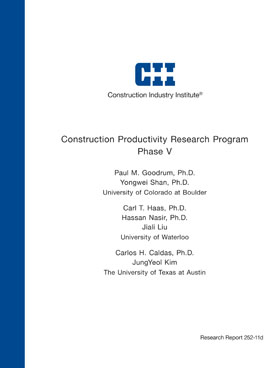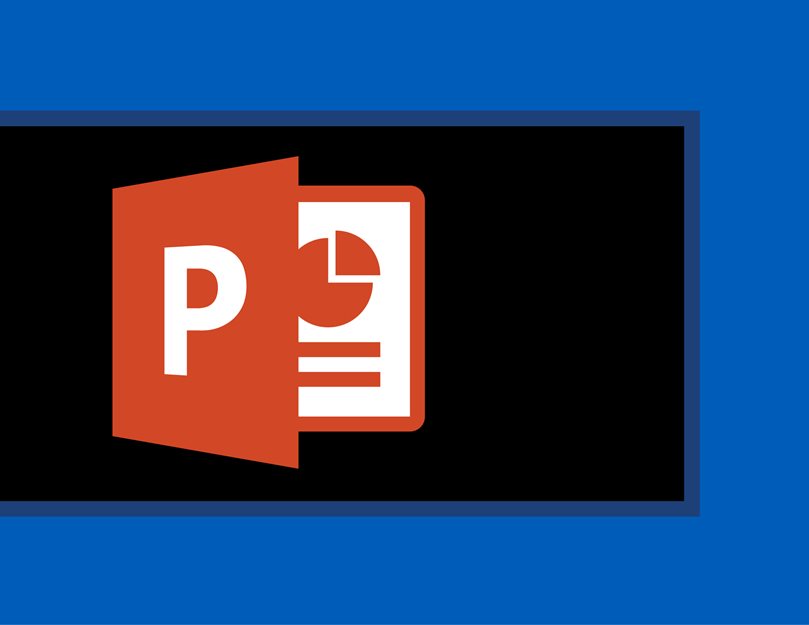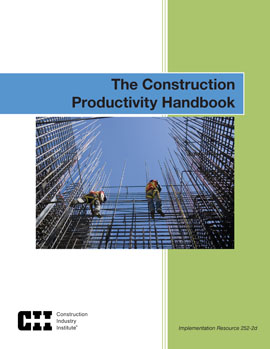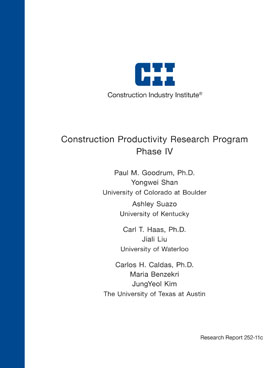
Construction Productivity Research Program -- Phase V
The CII Construction Productivity Program (RT 252) culminated in a number of analyses, strategies, methods, tools, and metrics to improve jobsite productivity. This final report of the six-year effort provides an overview of the previous phases, plus it details the validation and development of two versions of the Best Productivity Practices Implementation Index (BPPII), one version for industrial projects and another for commercial projects. This research report also details the analyses used to identify the significant body of knowledge regarding construction productivity that was incorporated into the Productivity Handbook.
Previous phases and reports of RT 252 have reported on the research and development of the Industrial BPPII. The BPPII is a metric to measure how effectively the methods, tools, and strategies known to improve construction productivity are being implemented on a construction jobsite. This report details the final validation efforts to confirm its accuracy. Using industrial project data on jobsite productivity, the validation efforts proved that projects with higher BPPII scores reported better productivity. This research report details the statistical analyses of the validation efforts.
Recognizing the growing diversity of the type of companies within the Construction Industry Institute, RT 252 developed and validated a BPPII for infrastructure projects. The process of using the Infrastructure BPPII is the same as its Industrial counterpart, but the methods, tools, and strategies are modified to address issues like utility relocation and right-of-way acquisition. Previous phases and reports have not discussed the Infrastructure BPPI, so this report debuts and finalizes both its development and validation. In a similar reporting fashion with the Industrial BPPII, this report details the statistical analyses, which showed that infrastructure projects that scored higher on the Infrastructure BPPII reported better jobsite productivity.
In its last year, the Construction Productivity Program team spent a great deal of effort on developing the Construction Productivity Handbook, which is a stand-alone reference of the body of knowledge regarding construction productivity. It is designed to be both a desktop reference and an educational tool for both construction professionals and universities. While developing the Construction Productivity Handbook, a significant body of analyses was done to examine the validation methodologies used in previous construction related research when identifying productivity improvement strategies. These analyses were used in part to identify the body of knowledge to include in the Productivity Handbook, and the results of those analyses are reported herein.
RT 252 made significant strides in its original mission of developing a roadmap of improving construction productivity. There are still endless opportunities to be explored to improve the industry’s productivity. Industry productivity measures continue to show that the productivity of the overall construction industry has been declining for decades, although these measures are counter intuitive to many and raise questions regarding the accuracy of industry measures. The development of the Industrial and Infrastructure BPPIIs addresses a core concern of CII companies, but there is a natural opportunity to extend the development of the BPPII process to commercial projects. What the BPPIIs have taught us is that no single method, strategy or tool is enough to control and improve construction productivity. Instead, it takes a comprehensive and unrelenting effort. The work of RT 252 is by no means a final statement on construction productivity. It is instead a continuation of a long research thread, and hopefully its work will be expanded and built upon by future research teams and academics.



